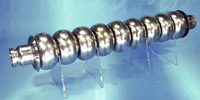Director's Corner
6 July 2006
 Barry Barish |
Demonstrating the ILC Accelerating Gradient
The central element of the ILC concept is the superconducting RF technology that will be used to accelerate electrons and positrons in the main linac. The choice of accelerating gradient is perhaps the single most important decision we have made, since it determines the length of the machine and has significant cost implications. Last December, we chose an aggressive peak gradient of 35MV/m and an operating gradient of 31.5 MV/m for our baseline. Yet, achieving this gradient in production cavities has not been demonstrated and will be a formidable challenge.
Nevertheless, we believe this gradient is a reasonable choice and establishes a realistic goal for our R&D program, especially considering what has already been achieved and what we project for TESLA-type superconducting cavities. It is also worth noting that in the longer term even higher gradients could be achieved with improved cavity shapes.
It is not an overstatement to say that our highest priority R&D goals during the reference and technical design phases of the next few years is to demonstrate high-gradient cavity performance and to establish the procedures that will be required to reliably fabricate and process the approximately 17000 cavities for the main linac. To achieve these goals, we are in the process of creating two related special task forces: one that will focus on the shorter-term cavity demonstration goals; and another that will look at the longer-term system tests, industrialisation, etc.
Recently, the newly formed GDE Machine Advisory Committee (MAC) emphasised (after endorsing our choice of gradient) the importance of our optimising the ILC cavity gradient and demonstrating that we can reach it. They said, " the committee believes that a very aggressive, world-wide, well-coordinated, R&D program is necessary to defend the case of an accelerating gradient as large as 35 MV/m."
We have defined three sets of goals: cavity production, process demonstrations (also known as S0 / S1 task force) and systems or cryomodule tests (S2). The S0 & S1 task force will be composed of H. Hayano (KEK), T. Higo (KEK), L. Lilje (DESY – Chair), J. Mammosse (JLab), H. Padamsee (Cornell), M. Ross (Fermilab) and K. Saito (KEK).
The charge for the S0 / S1 task force has been defined as the following:
"The RDB is asked to set up a Task Force to carry out a closely coordinated global execution of the work leading to the achievement of the accelerating gradient specified in the ILC Baseline.
A definition of the R&D goals for the cavity performance in terms of gradient and yield and a plan for achieving them should be proposed by this group, which should take account of the global resources available and how they may be used most rapidly and efficiently.
The accelerating gradient performance and yield should be specified for cavity production, and treatment process (S0), and for cryomodules (S1), and the plan should cover the demonstration of this performance in all cases.
The GDE will facilitate the coordination at the global level to achieve this vital goal as soon as possible."
The S0 goal for demonstrating cavity performance and defining the fabrication and surface preparation process is to achieve vertical test yield for 35 MV/m at Q 0 = 10 10 greater than 90%. The original goal in our baseline was to achieve a distribution of cavity gradients of 37 +/- 5% MV/m. However, yield is a more important project parameter and, for that reason, the task force is reformulating the goals in terms of this parameter. The S1 goal is that 31.5 MV/m at a Q 0=10 10 must be demonstrated as the ILC operational gradient in more than one module of eight cavities. The cavity demonstration programme is essential to reliably determine the highest practical gradient to employ in the ILC, and to establishing optimum cost-to-performance.
I will discuss the companion R&D to the cavity demonstrations in my next column. This involves building large test facilities with strings of cryomodules, and is an essential step in preparing for industrialisation of the main linac components.
-- Barry Barish
